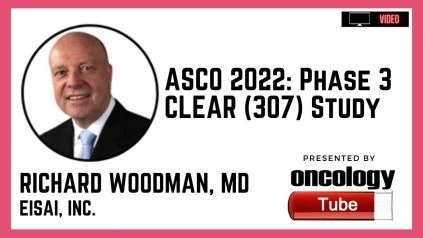Richard Woodman, MD Chief Clinical Officer, Oncology Business Group at Eisai, Inc.. In this video, he speaks about the ASCO 2022 Abstract – Impact of subsequent therapies in patients (pts) with advanced renal cell carcinoma (aRCC) receiving lenvatinib plus pembrolizumab (LEN + PEMBRO) or sunitinib (SUN) in the CLEAR study (307).
Origins:
In the open-label, randomized, phase 3 CLEAR trial, LEN + PEMBRO outperformed SUN in terms of PFS (primary endpoint) and OS (key secondary endpoint) in patients with aRCC in the 1L scenario (Motzer 2021, NEJM). In the CLEAR LEN + PEMBRO and SUN treatment groups, we assessed PFS on second-line therapy (“PFS2”) and investigated the influence of subsequent anticancer therapy on OS.
Methodology:
PFS2 was defined as the time elapsed between randomization and disease progression (as determined by the investigator) on next-line treatment or death from any cause (whichever occurred first). PFS2 was calculated using Kaplan-Meier estimates in all patients randomly assigned to LEN 20 mg orally QD + PEMBRO 200 mg IV Q3W (n=355) or SUN 50 mg orally QD (4 wks on/2 wks off) (n=357) and compared between treatment arms using a log-rank test stratified by geographic region and MSKCC prognostic groups. Using the same stratification factors, the HR and accompanying CI were computed using the Cox regression model with Efron’s technique for ties. A post hoc analysis utilizing 2-stage estimation was performed in the LEN + PEMBRO and SUN arms to account for the effect of subsequent anticancer therapy on OS (time from randomization to death from any cause).
Outcomes:
The median time to next-line therapy in the LEN + PEMBRO (n=117 pts) and SUN (n=206 pts) groups (Table) was 12.2 months (range 1.45–37.36) and 6.4 months (range 0.39–28.52), respectively. The median length of first subsequent anticancer therapy in the LEN + PEMBRO arm was 5.2 months (range 0.10–30.23) and 6.8 months (range 0.03–30.72) in the SUN arm. PFS2 lasted longer with LEN + PEMBRO than with SUN (median not attained vs 28.7 mos; HR, 0.50; 95 percent CI 0.39–0.65; nominal P0.0001); PFS2 rates at 24 and 36 months are shown in the table. The uncorrected OS HR for LEN + PEMBRO vs SUN was 0.66 (95 percent CI 0.49–0.88) (from the primary study [Motzer 2021, NEJM]; the HR for OS adjusted for future therapy was 0.54 (bootstrap 95 percent CI 0.39–0.72).
Findings:
In the CLEAR research, LEN + PEMBRO exhibited a statistically significant and clinically meaningful advantage over SUN. After accounting for subsequent therapy, these outcomes were similar, as demonstrated by prolonged PFS2 and adjusted OS. The findings support the use of LEN + PEMBRO as a standard of care in 1L aRCC. NCT02811861 is the clinical trial number.

